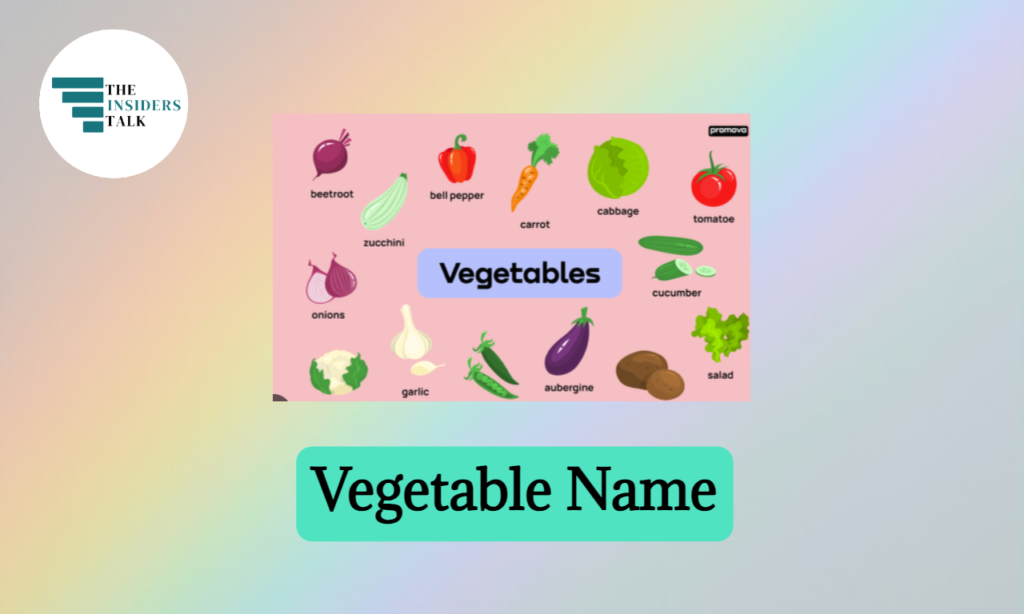Vegetables and fruits are essential for overall well-being because of their rich nutritional content. They provide essential vitamins, minerals and antioxidants that strengthen our immune system, promote healthy digestion and reduce the risk of chronic diseases such as heart disease and some cancers. In addition, they are low in calories and high in fiber, which helps with weight loss and maintains a healthy digestive system. Eating a variety of vegetables and fruits provides a balanced and nutritious diet that supports our overall health and vitality. Here we have discussed names of a few vegetables in Hindi and English.
Vegetable Name
Friends, we know very well that everyone eats vegetables and you probably have never seen someone who doesn’t. Our staple food, vegetables, is also very beneficial for our health. Different vegetables are grown everywhere. And although we know the names of some of these vegetables, we don’t. This is because while some vegetables are only found in certain regions or countries, others are found all over the world.
Vegetable Names in English and Hindi
Here is a list of 50 vegetable names written in a table in English and Hindi.
| Vegetable Names in English and Hindi | |
| English | हिंदी अर्थ |
| Tomato | टमाटर |
| Bottle Gourd | लौकी |
| Potato | आलू |
| Pea | मटर |
| Green Chili | हरी मिर्च |
| Cucumber | खीरा |
| Onion | प्याज |
| Cauliflower | फूल गोभी |
| Bitter Gourd | करेला |
| Pointed Gourd | परवल |
| Cabbage | बंद गोभी |
| Beat-root | चुकंदर |
| Bean | सेम |
| Jack-fruit | कटहल |
| Ridge Gourd | तरोई |
| Sponge Gourd | नेनुआ (घेवडा) |
| Ginger | अदरक |
| Capsicum | शिमला मीर्च |
| Pumpkin | कद्दू |
| Brinjal | बैगन |
| Spinach | पालक |
| Coriander Leaf | धनिया पत्ता |
| Round Melon | टिंडा |
| Colocasia Root | अरवी |
| Turnips | शलजम |
| Mushroom | मशरूम |
| Garlic | लहसून |
| Sweet-Potato | शकरकंद (गंजी) |
| Green Onion | हरा प्याज |
| Dill | सोया |
| Radish | मूली |
| Mint | पुदीना |
| Soya beans | सोयाबीन |
| Green-Mustard | हरा सरसों |
| Wild Spinach | जंगली पालक |
| Fava beans | बाकला |
| French beans | फ्रेंच बीन्स |
| Kideny beans | राजमा |
| Drumstick | सहजन |
| Tendli Gourd | कुदरुन |
| White Brinjal | सफेद बैगन |
| Curry leaves | करी पत्ता |
| Tamarind | इमली |
| Raw papaya | कच्चा पपीता |
| Olive | जैतुन |
| Natal plum | करौंदा |
| Keri | कच्चा आम/ अमिया |
| Baby corn | मक्का |
| Cluster beans | ग्वार की फली |
| Amaranth leaves | चौराई |
| Yam | रतालु |
| Ash gourd | पेठा |
| Spine gourd | ककोर |
| Red chili | लाल मिर्च |
| Chickpea | काबुली चना |
| Lotus cucumber | कमल ककड़ी |
| Runner beans | सेम की फली |
| Elephant foot yam | जिमीकंद |
| Cassava | कसावा |
| Chives | प्याज का पत्ता |
| Ceylon spinach | पोई |
| Raw banana flower | कच्चे केले का फूल |
| Bamboo shoot | बांस के कोपले |
| Taro root | कान्दू |
| Cape gooseberry | केप करौंदा |
| Amaranth | अम्लान पुष्प |
| Arugula | आर्गुला |
| Fennel | सौंफ |
| Fenugreek leaf | मेथी |
| Jute Flower | सनैल का फूल |
| Lady-Finger | भिन्डी |
Examples Of Different Types Of Vegetables
- Green leafy vegetables: These green leafy vegetables are very nutritious and are usually eaten raw in salads or cooked. For example, spinach (dark green and soft), lettuce (crunchy and fresh) and kale (nutrient dense and slightly bitter).
- Marrow: These vegetables belong to the squash family and have soft, edible flesh and seeds. Examples include pumpkin (mild and versatile), butternut squash (sweet and often used in pies), and butternut squash (sweet and creamy).
- Root Vegetable: These vegetables grow underground and are rich in carbohydrates. Examples include carrots (orange and crunchy), potatoes (starchy and versatile) and beets (sweet and earthy).
- Allium: Allium vegetables have a distinctly pungent odor and taste. For example, onions (pungent and aromatic), garlic (strong and aromatic) and leeks (mild and bulbous).
- Legumes: These vegetables grow in pods and are often eaten in pods. For example, peas (sweet and soft) and beans (different types, such as green beans and kidney beans, each with a unique taste and texture).
- Nightshade Vegetables: Nightshade vegetables are known for their shiny edible fruits. For example, tomatoes (juicy and versatile), peppers (sweet and crunchy) and eggplants (earthy and meaty).
Importance of Vegetables
- Vegetables are nutrient-rich foods that are abundant in vitamins (A, C, and K), minerals (potassium and magnesium), and dietary fiber—all of which are necessary for a variety of body processes.
- Disease prevention: Eating veggies on a regular basis has been associated with a lower chance of developing chronic illnesses including diabetes, heart disease, and several kinds of cancer. Vegetables’ antioxidants and phytochemicals support a stronger immune system and aid the body’s defense against toxins.
- Digestive Health: Dietary fiber, which helps with digestion and prevents constipation, is abundant in vegetables. Moreover, fiber supports a healthy gut flora, which is critical for maintaining digestive health in general.
- Weight management: Vegetables are high in fiber and low in calories and fat.



